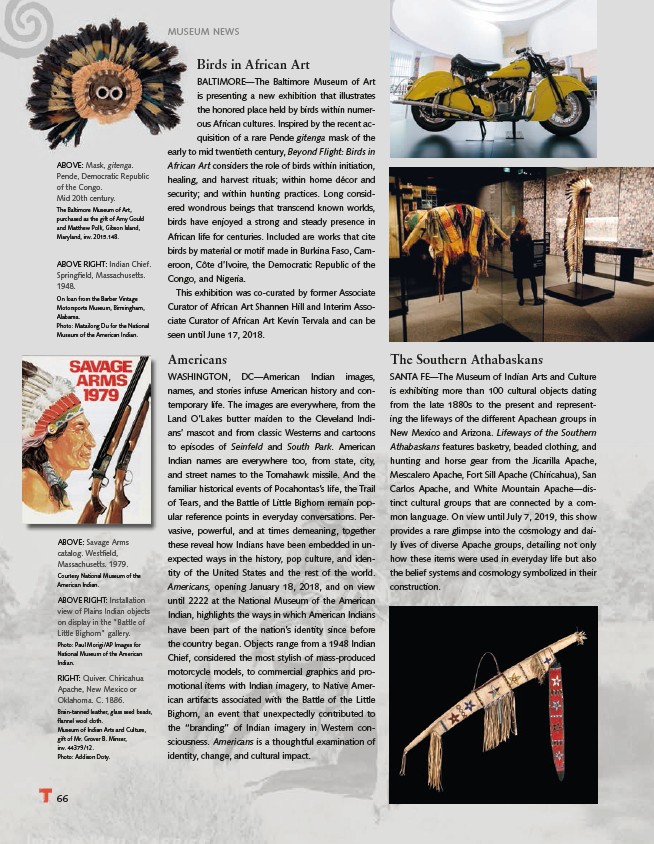
66
MUSEUM NEWS
Birds in African Art
BALTIMORE—The Baltimore Museum of Art
is presenting a new exhibition that illustrates
the honored place held by birds within numerous
African cultures. Inspired by the recent acquisition
of a rare Pende gitenga mask of the
early to mid twentieth century, Beyond Flight: Birds in
African Art considers the role of birds within initiation,
healing, and harvest rituals; within home décor and
security; and within hunting practices. Long considered
wondrous beings that transcend known worlds,
birds have enjoyed a strong and steady presence in
African life for centuries. Included are works that cite
birds by material or motif made in Burkina Faso, Cameroon,
Côte d’Ivoire, the Democratic Republic of the
Congo, and Nigeria.
This exhibition was co-curated by former Associate
Curator of African Art Shannen Hill and Interim Associate
Curator of African Art Kevin Tervala and can be
seen until June 17, 2018.
Americans
WASHINGTON, DC—American Indian images,
names, and stories infuse American history and contemporary
life. The images are everywhere, from the
Land O’Lakes butter maiden to the Cleveland Indians’
mascot and from classic Westerns and cartoons
to episodes of Seinfeld and South Park. American
Indian names are everywhere too, from state, city,
and street names to the Tomahawk missile. And the
familiar historical events of Pocahontas’s life, the Trail
of Tears, and the Battle of Little Bighorn remain popular
reference points in everyday conversations. Pervasive,
powerful, and at times demeaning, together
these reveal how Indians have been embedded in unexpected
ways in the history, pop culture, and identity
of the United States and the rest of the world.
Americans, opening January 18, 2018, and on view
until 2222 at the National Museum of the American
Indian, highlights the ways in which American Indians
have been part of the nation’s identity since before
the country began. Objects range from a 1948 Indian
Chief, considered the most stylish of mass-produced
motorcycle models, to commercial graphics and promotional
items with Indian imagery, to Native American
artifacts associated with the Battle of the Little
Bighorn, an event that unexpectedly contributed to
the “branding” of Indian imagery in Western consciousness.
Americans is a thoughtful examination of
identity, change, and cultural impact.
ABOVE: Savage Arms
catalog. Westfi eld,
Massachusetts. 1979.
Courtesy National Museum of the
American Indian.
ABOVE RIGHT: Installation
view of Plains Indian objects
on display in the "Battle of
Little Bighorn" gallery.
Photo: Paul Morigi/AP Images for
National Museum of the American
Indian.
RIGHT: Quiver. Chiricahua
Apache, New Mexico or
Oklahoma. C. 1886.
Brain-tanned leather, glass seed beads,
fl annel wool cloth.
Museum of Indian Arts and Culture,
gift of Mr. Grover B. Minser,
inv. 44379/12.
Photo: Addison Doty.
The Southern Athabaskans
SANTA FE—The Museum of Indian Arts and Culture
is exhibiting more than 100 cultural objects dating
from the late 1880s to the present and representing
the lifeways of the different Apachean groups in
New Mexico and Arizona. Lifeways of the Southern
Athabaskans features basketry, beaded clothing, and
hunting and horse gear from the Jicarilla Apache,
Mescalero Apache, Fort Sill Apache (Chiricahua), San
Carlos Apache, and White Mountain Apache—distinct
cultural groups that are connected by a common
language. On view until July 7, 2019, this show
provides a rare glimpse into the cosmology and daily
lives of diverse Apache groups, detailing not only
how these items were used in everyday life but also
the belief systems and cosmology symbolized in their
construction.
ABOVE: Mask, gitenga.
Pende, Democratic Republic
of the Congo.
Mid 20th century.
The Baltimore Museum of Art,
purchased as the gift of Amy Gould
and Matthew Polk, Gibson Island,
Maryland, inv. 2015.148.
ABOVE RIGHT: Indian Chief.
Springfi eld, Massachusetts.
1948.
On loan from the Barber Vintage
Motorsports Museum, Birmingham,
Alabama.
Photo: Matailong Du for the National
Museum of the American Indian.